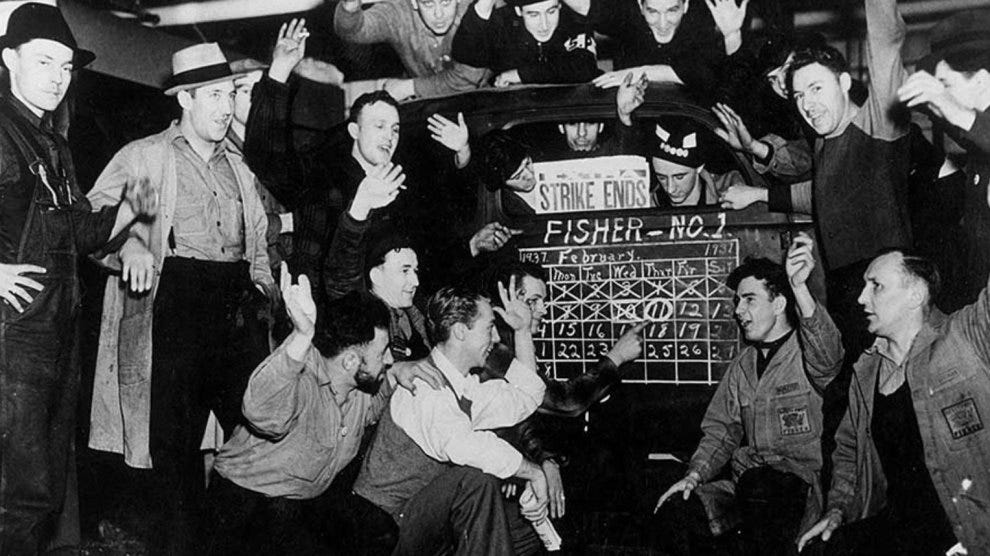The First UAW Strikes, in 1930s, Changed Everything
Current labor activists stand on their shoulders. My new article at Mother Jones, from my book and film.
Greg Mitchell is the author of a dozen books and now writer/director of award-winning films. He was also the longtime executive editor of the legendary Crawdaddy. And see his popular new newsletter devoted to The Bomb in the wake of “Oppenheimer.” His two newsletters remain free when you subscribe. His film “Atomic Cover-up” became free via Kanopy this month.
I’ve got a timely new piece up at Mother Jones today, my fourth contribution there in the past couple of months, which opens this way:
On Tuesday, leaders of the striking United Auto Workers vowed to expand their labor action against the Big Three automakers Friday if contract talks break down. Now in its second week, the strike has drawn widespread attention, but it’s only the latest indication of the broader resurgence of union organizing by the likes of Starbucks workers, big city teachers’ unions, Marvel digital effects workers, Uber and Lyft drivers, and, of course, Hollywood actors and screenwriters. In August, the threat of a United Parcel Service strike with Teamster support resulted in a new contract, and some of Amazon’s massive warehouses are simmering with labor unrest.
Yet all of today’s labor organizers stand on the shoulders of their forebears who, during the mid-1930s, amid the depths of the Great Depression, established or expanded key unions in the steel and auto industries and founded all of the Hollywood guilds. Central to many of their advances was a fresh tactic: “sit down strikes,” wherein workers would stay put in their factories and workspaces, not to be easily dislodged. This strategy brought about widespread victories, benefiting everyone from Woolworth’s lunch-counter workers to (as we’ll see) assembly line workers at GM and Ford. Unions remained powerful for decades, although a concerted effort by business leaders and their Republican friends in Congress, and moving of jobs overseas, would ultimately erode their membership gains. Today, only about 10 percent of US employees belong to a union.
The following commentary, adapted from my recent oral history book and PBS film, Memorial Day Massacre: Workers Die, Film Buried, takes us back to that earlier era and tells the story of how things went down in the 1930s.
Another excerpt below. But first: My recent post here on that book and film, and earlier Mother Jones piece on the massacre (Chicago police killing ten labor activists in 1937) and film cover-up that followed. The PBS film is now available for everyone everywhere to view (at 27 minutes) for no charge via the film’s main site, which includes background and praise from numerous notables, or very easily via PBS.org and PBS apps. It’s produced by Lyn Goldfarb and narrated by Josh Charles.
The companion book is the first oral history of the tragedy. The book (my 13th), in both paperback and as an e-book, features eyewitness accounts by numerous activists and the wounded, and compelling and unique reflections by the likes of Gore Vidal, Studs Terkel, Howard Zinn, Howard Fast, and Dorothy Day, even a cameo by Ayn Rand.
Now that excerpt from today’s piece.
Howard Zinn: The idea of sit-down strikes spread through 1936. In December of that year began the longest sit-down strike of all, at Fisher Body plant #1 in Flint, Michigan. It started when two brothers were fired, and it lasted until February 1937. For forty days there was a community of 2,000 strikers. “It was like war,” one said. “The guys with me became my buddies.”
Sidney Fine in Sit-Down describes what happened: Committees organized recreation, information, classes, a postal service, sanitation. Courts were set up to deal with those who didn’t take their turn washing dishes or who threw rubbish or smoked where it was prohibited or brought in liquor. A restaurant owner across the street prepared three meals a day for two thousand strikers. There were classes in parliamentary procedure, public speaking, history of the labor movement. Graduate students at the University of Michigan gave courses in journalism and creative writing.
There were injunctions, but a procession of 5,000 armed workers encircled the plant and there was no attempt to enforce the injunction. Police attacked with tear gas and the workers fought back with firehoses. Thirteen strikers were wounded by gunfire, but the police were driven back. The governor called out the National Guard. By this time the strike had spread to other General Motors plants. Finally there was a settlement, a six-month contract, leaving many questions unsettled but recognizing that from now on, the company would have to deal not with individuals but with a union.
In 1936 there were 48 sit-down strikes. In 1937 there were 477: electrical workers in St. Louis; shirt workers in Pulaski, Tennessee; broom workers in Pueblo, Colorado; trash collectors in Bridgeport, Connecticut; gravediggers in New Jersey…The sit-downs were especially dangerous to the system because they were not controlled by the regular union leadership.
Studs Terkel: Though the breadline was beginning to resemble an endless, silent, gray snake dance, there was a salubrious note in the air. Flutelike. Something around the corner. Not prosperity, no. That had always been around the corner, but never quite made the turn. Something funny had happened. There was a deep Depression, true, but an elfin air pervaded, as insouciant as Roosevelt’s tilted cigarette holder. Hope has never trickled down, it has always sprung up.




Hard history, lesson. Especially now when new voices are being raised for fair wages and working conditions. Whether it’s this massacre or the Lattimer dead, (and countless forgotten others) we need these reminders. Thank you.